Understanding Search Intent in SEO
In today’s highly digitized world where Google has become our go-to source for answers, mastering SEO has become more crucial than ever.
Navigating the complex world of SEO can feel as though you’re trying to learn a new language, particularly when it comes to comprehending Google’s search results. Google displays a different result page layout based on the user search. This is triggered by a users ‘Search Intent’.
Search intent is the purpose behind a search query. When someone searches for something on Google, they are not just looking for random information. They have a specific purpose in mind, and they want to find content that matches their needs.
Search intent is essential for both users and search engines. Users want to find content relevant to their needs, and search engines want to provide the best search results.
Background
MRK WP offers SEO services as part of some care plans. This service includes providing consultation on SEO inquiries made by our clients. This week, we received an SEO inquiry from one of our clients:
Hey Matt,
When I google “oversize banner”, why does our “Over Signs for Trucks” page come up as our result instead of the actual Oversize banner page?
Also, how do we increase our results in the Google shopping pages?
Client // Advance Global
When you look into this inquiry, you will realise the client needs to understand how Google search results are influenced by a user’s search intention. They would like to understand why the ‘Over Signs for Trucks‘ category page shows up instead of the actual ‘Oversize banner‘ product page.
In this article and video, we will respond to the client’s inquiry by helping them understand the different types of search intent. We will also explain how search engines match users to results depending on the content of their searches.
Table of contents
Video: Demystifying Search Intent
Check out this video on demystifying search intent. In this video, we explain the search types out there. We also share hints and how to design your content based on the search types to improve your SEO.
What is Search Intent?
Search intent is the purpose behind a search query. In other words, it’s what the searcher is looking for when using a search engine like Google.
Types of Search Intent
There are four main types of Google searches, these are:
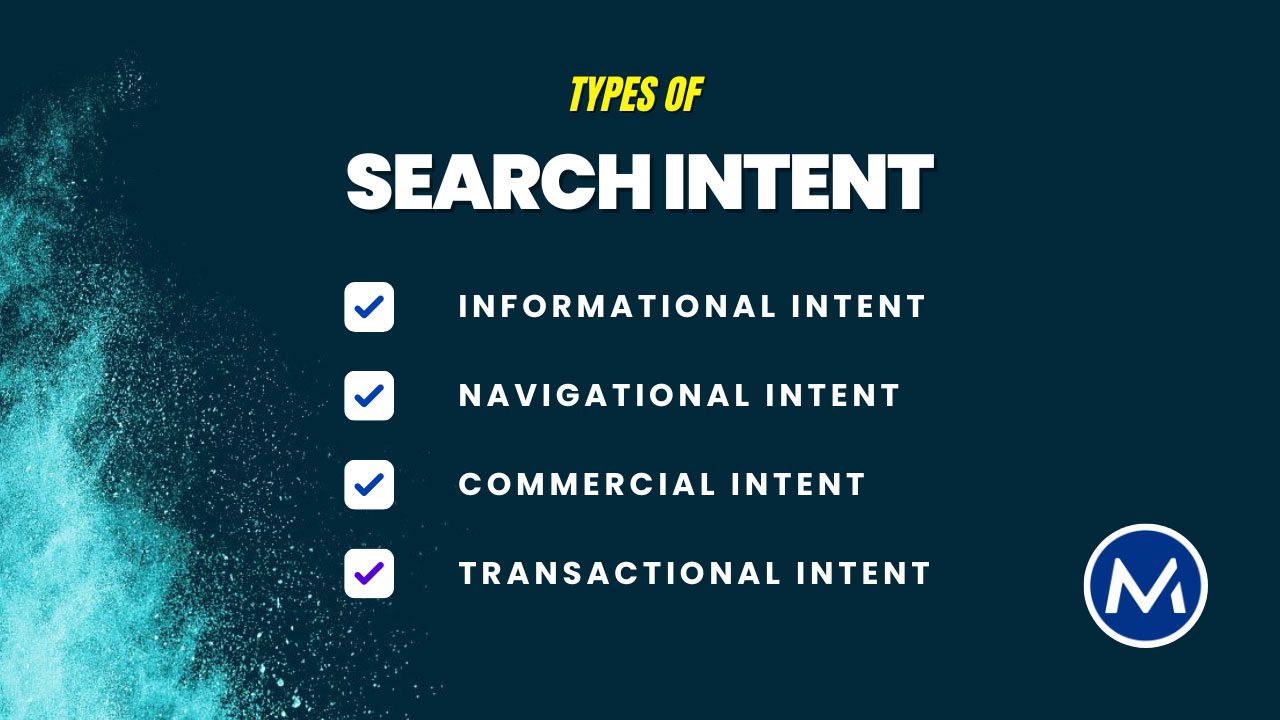
1. Informational Intent
Users with informational intent have a specific question or want to know more about a topic. They may be looking for a definition, a tutorial, or a list of resources. They are not necessarily looking to buy anything or take any specific action.
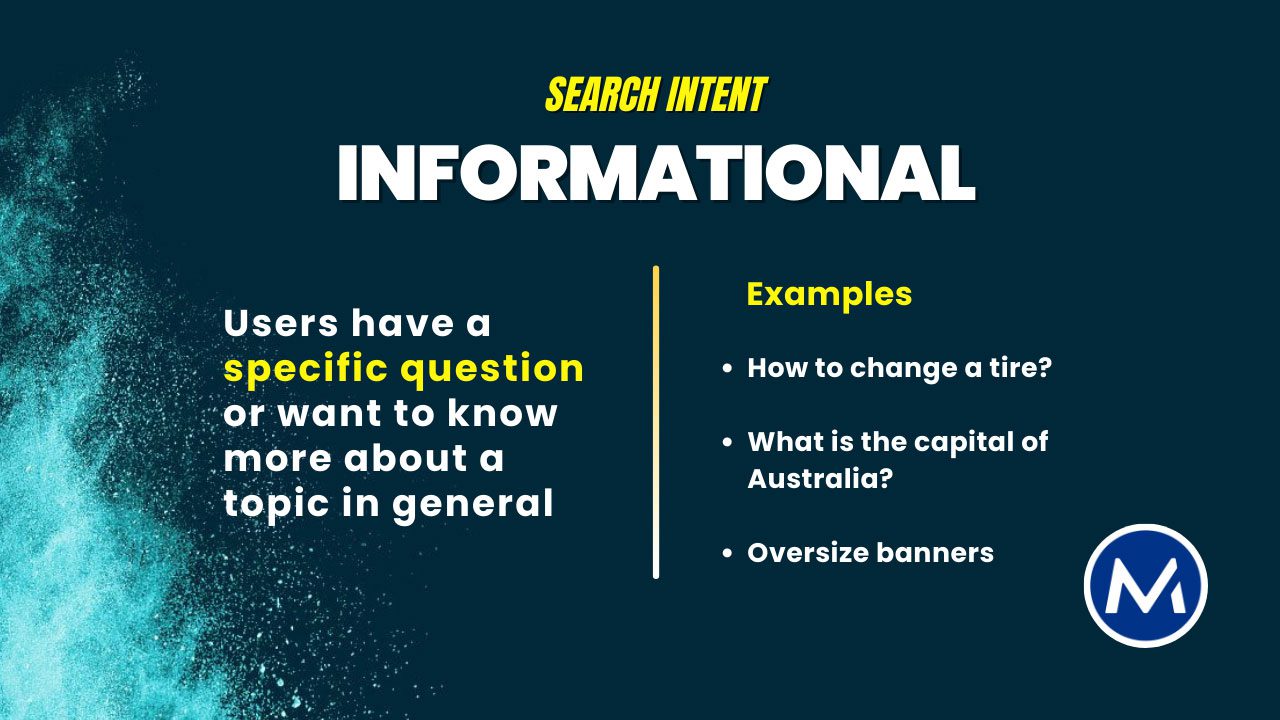
For example, someone might search for:
- How to change a tire?
- What is the capital of Australia?
- Oversize banners
Informational search queries may often contain words like “how,” “what,” “why,” “where,” and “who.” They may also be phrased as questions.
When users do informational queries in Google, general information or category pages appear in the search results instead of single product pages.
It is because the user wants general information on ‘Oversize banners‘. They want to know what these are, their use, where to find them(suppliers), etc.
They are not interested in purchasing the items. Therefore, Google will wait before showing them the single product pages.
2. Navigational Intent
This search type is when a user is looking for a specific website or page. They may have bookmarked the website or page in the past, or they may have heard about it from a friend or colleague.
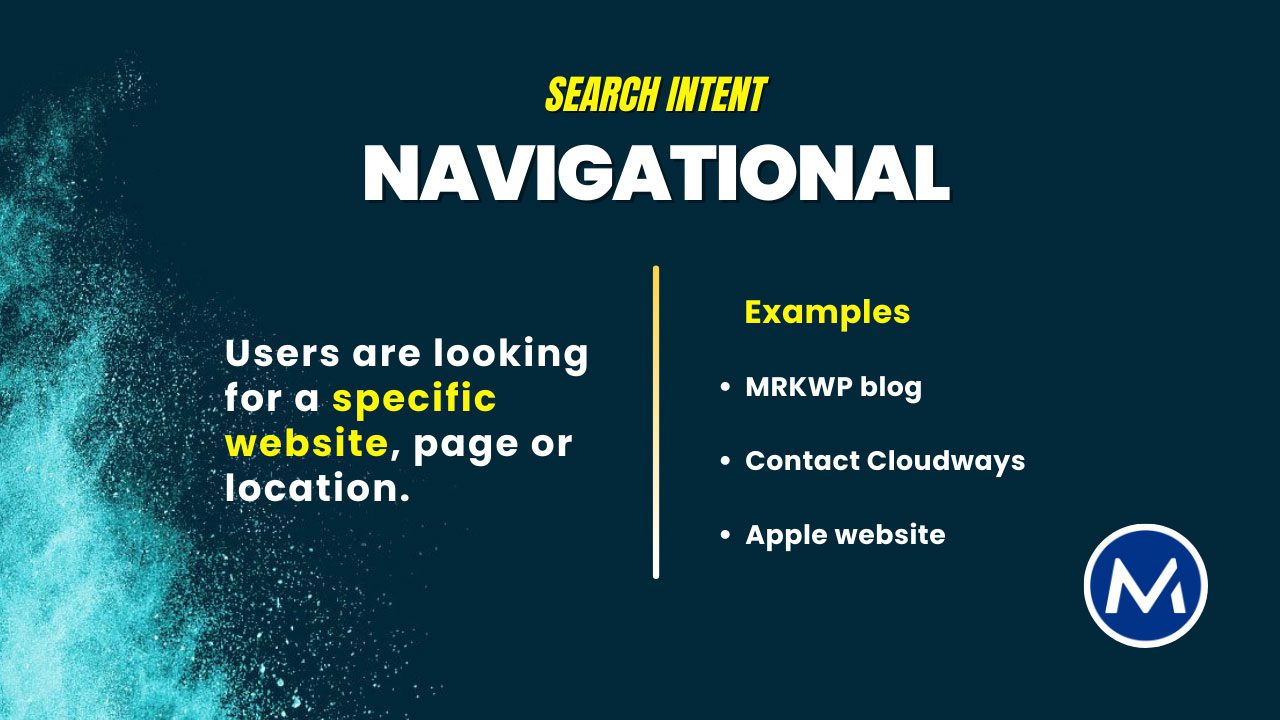
Users here are not necessarily looking for information about the website or page, but want to be taken directly to it.
Navigational search intent queries often contain the website or page name in the query. Examples include;
- “MRK WP contact page” when looking for MRKWP’s contact page.
- “MRK WP blog” to access the blog page for MRK WP
3. Commercial Intent
Users with commercial intent are looking to buy something, but they are not necessarily ready to make a purchase yet. They are still doing their research and comparing different options. They may be looking for product reviews, pricing information, or comparison articles.
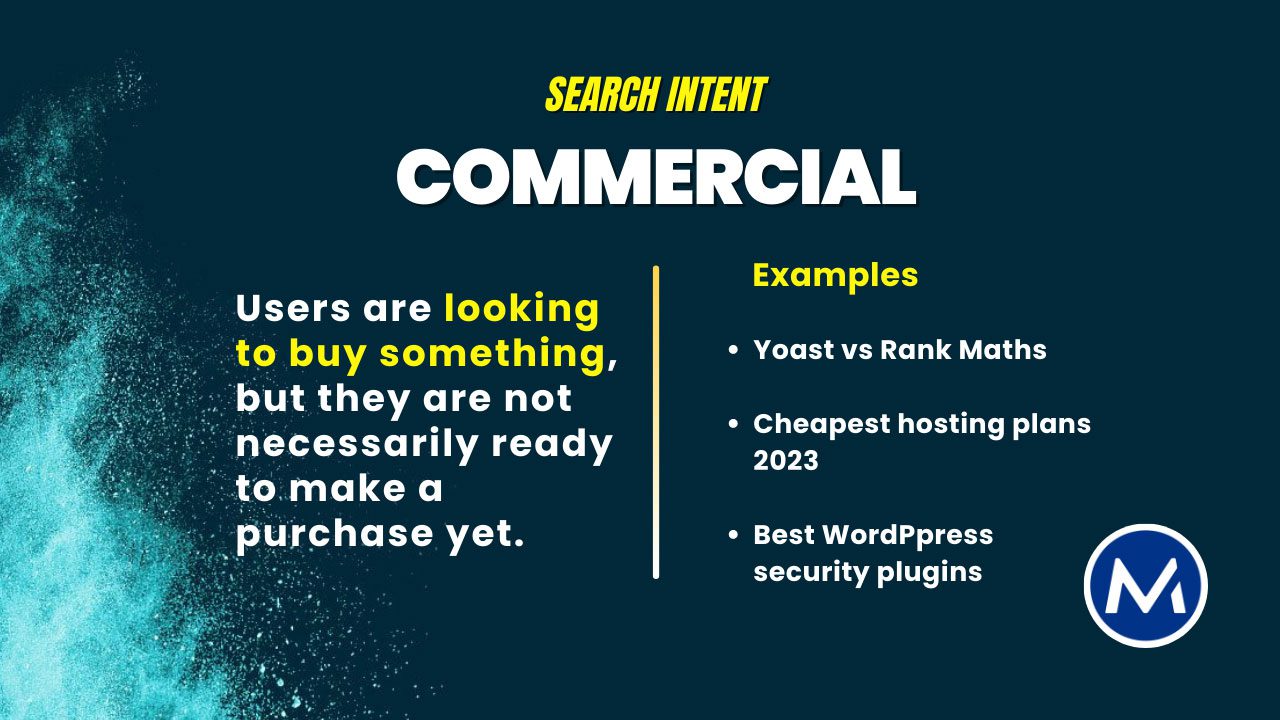
For example, someone might search for “Yoast vs Rank Maths” or “cheapest hosting plans 2023“. In this type of search, the user has an idea about the product or service but wants to compare or land on the best deal for that product.
4. Transactional Intent
Users with transactional intent are ready to make a purchase. They have already researched the products; that is, they have covered both information and commercial searches.
The user at this stage is now looking for a specific product or service to buy as quickly and efficiently as possible.
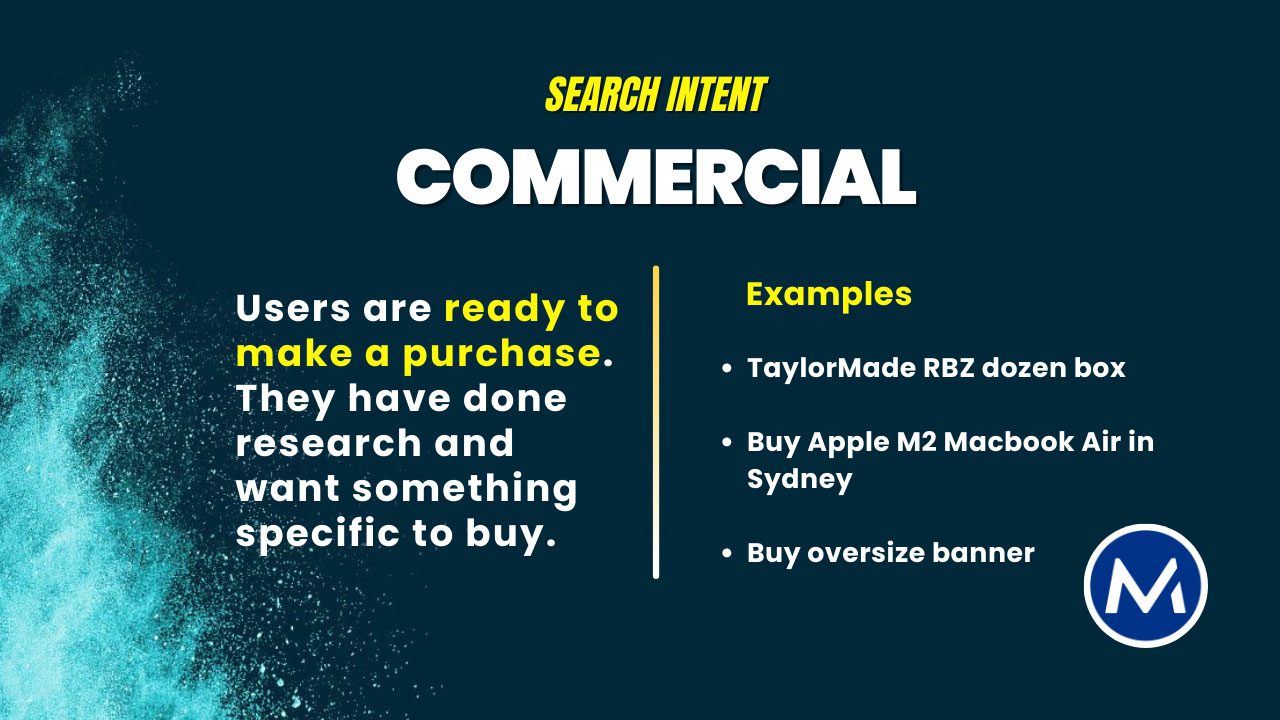
For example, someone might search for:
- TaylorMade RBZ dozen box – to know how much the dozen of golf balls by this brand cost.
- Buy Apple M2 MacBook price in Sydney – to confirm where they can buy the laptop.
- Buy oversize banner – to see the various oversize banner on the market and their prices.
With transactional queries, Google will display a shopping carousel at the top of the search results to assist the user in making the best purchase decision.
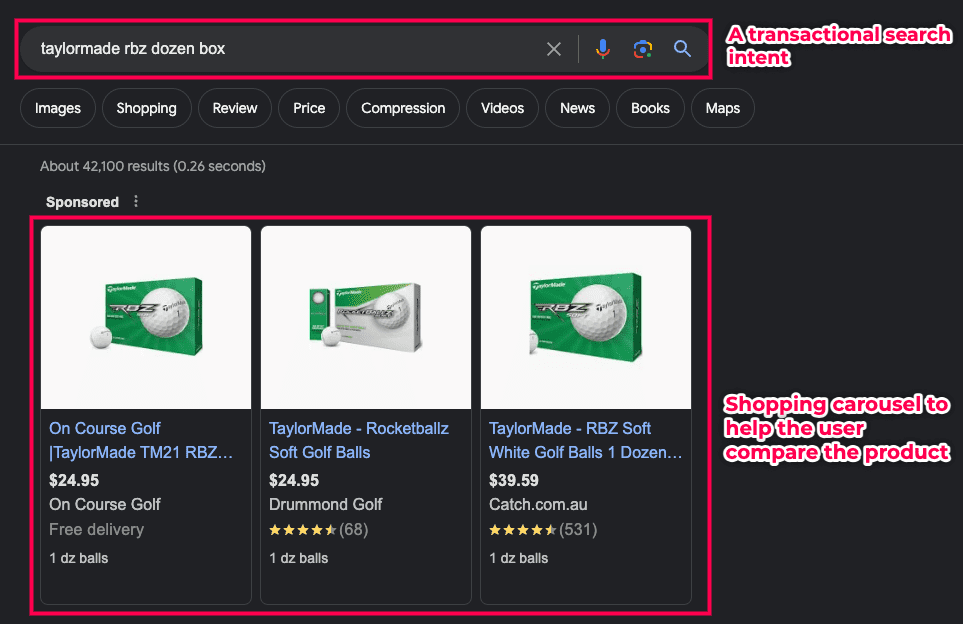
Search Goals
It’s important to understand Google search intent when creating content for your website. If you create content that doesn’t match the search intent of your target audience, you’re less likely to rank well in search results.
For example, if you’re creating a blog post about how to change a tire, you should ensure that your content is informative. It should answer the questions your target audience will likely have. Create something other than a blog post that is just a sales pitch for your tire-changing service.
By understanding search goals, you can create content that is more likely to rank well in search results. This will attract the right visitors to your website.
How to Determine Google Search Intent
There are a few ways to determine Google search intent:
- Look at the keywords: People using keywords in their search queries can give you a good indication of their search intent. For example, keywords like “how to” and “what is” are often associated with informational intent. Other keywords like “buy” and “best” are often associated with commercial intent.
- Look at the search results: The search results for a particular query can also give you clues about the search intent. For example, if the top results for a query are all articles and blog posts, then it’s likely that the search intent is informational. If the top results are all product pages, then it’s likely that the search intent is commercial.
- Use Google’s Search Quality Evaluator Guidelines: Google publishes guidelines for search quality evaluators. These guidelines help you understand the different types of searches. It guides you and how to create content that matches the search intent of your target audience.
How to Optimize Your Content for Google Search Intent
Once you understand the search intent of your target audience, you can optimize your content to match their needs. Here are a few tips:
- Use the right keywords: Use the keywords your target audience will likely use in their search queries. This will help your content rank higher in search results.
- Write informative content: If your target audience has informational intent, ensure that your content is informative. The content should answer the questions they are likely to ask.
- Use a clear call to action: If your target audience has commercial intent, make sure that your content includes a clear call to action. Examples of calls to action include “buy now” or “contact us.”
- Use relevant images and videos: Images and videos can be a great way to break up your text and make your content more visually appealing. They can also help demonstrate a concept or process.
Conclusion
Google search intent is an important concept to understand if you want to create successful content on Google. You can increase your chances of ranking well in search results by creating content matching users’ search intent.
By following these tips, you can optimize your content for Google search intent and attract the right visitors to your website.
Rember, you should make the right choice when picking an SEO agency. It should be in a position to help you optimise your content for these search intent types. You can also can reach out to us to assist with other SEO-related services.
